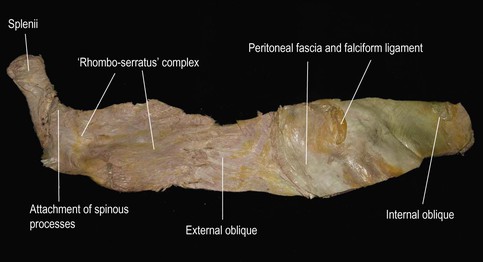Which Myofascial Tracks Does the Lateral Line Share With the Spiral Line?

Fig. 6.7 The same specimen as Figure 6.4, viewed from the profound side. The peritoneum and transversalis fascia, as well as the remnants of the falciform ligament, can be seen in the lower (right) part of the specimen. The attachments of the serratus and external obliques to the ribs can be seen, as well as the stark fact of the stronger attachment that both muscles have for each other than either has for the ribs.

 The internal and external oblique complex
The internal and external oblique complex
From the lower attachments of the serratus, our way forward is clear: the serratus anterior has strong fascial continuity with the external oblique ( Figs 6.7 and 6.8 ). The fibers of the external oblique blend into the lamina of the superficial abdominal aponeurosis, which carries over to the linea alba, where they mesh with the opposing fibers of the internal oblique on the opposite side ( Fig. 6.7 ). This carries us to our next 'station', the ASIS (anterior superior iliac spine) and an opportunity for a brief sidetrack, or, in this case, a roundhouse (see 'Roundhouse: the anterior superior iliac spine' below).
In the abdomen, one set of external/internal oblique (abdominal ribs to opposite pelvis) complex may be visibly shorter than the other ( Fig. 6.9 ). Position the fingertips into the superficial layers of abdominal fascia and lift them diagonally and superiorly toward the opposite ribs (DVD ref: Spiral Line, 12:28–16:00). ![]() This will usually serve to correct this imbalance, although more complex counterbalancing patterns often involve the psoas as well (see Ch. 9).
This will usually serve to correct this imbalance, although more complex counterbalancing patterns often involve the psoas as well (see Ch. 9).

 Roundhouse: the anterior superior iliac spine
Roundhouse: the anterior superior iliac spine
The SPL passes over the anterior superior iliac spine (ASIS), touching there as a station before passing down the leg. The ASIS is of such central importance to structural analysis in general, and myofascial continuity theory in particular, that we must pause here to note the various mechanical pulls from this point. It could be compared to a clock or a compass, but since we are mired in train images for this book, we will call it a roundhouse (Fig. 2.11B, p. 71).
The internal oblique pulls the ASIS in a superior and medial direction ( Fig. 2.11A ). Other internal oblique fibers, as well as fibers from the transversus abdominis, pull directly medially. Still other fibers of the internal oblique fan, plus the restraining cord of the inguinal ligament, pull medial and inferior. The sartorius, attaching to the ASIS on its way to the inner knee, pulls mostly down and slightly in. The iliacus, clinging to the inside edge of the ASIS, pulls straight down toward the inner part of the femur.
The rectus femoris, as we noted in discussing the Superficial Front Line, does not attach to the ASIS in most people; nevertheless it exerts a downward pull on the front of the hip from its attachment a bit lower on the AIIS. The tensor fasciae latae pulls down and out on its way to the outer aspect of the knee. The gluteus medius pulls down and back toward the greater trochanter, the transversus abdominis pulls back nearly horizontally along the iliac crest, and the external oblique pulls up and back toward the lower edge of the rib cage.
Getting all these forces to balance around the front of the hip in both standing and gait involves an attentive eye, progressive work, and more than a little patience. This balance involves at least three of the Anatomy Trains lines – this Spiral Line, the Lateral Line, the Deep Front Line, and, by mechanical connection, the Superficial Front Line. Proper assessment involves weighing an ever-shifting dance of pulls created by a host of myofascial units across each semi-independent side of the pelvis.
Because of the many pulls and tracks competing to set the position of the ASIS, the SPL does not always win out in communicating between its upper track (the skull to ribs to hip portion we have just covered) and its lower track (the 'jump rope' around the arches we are about to cover). Therefore, we often assess and consider these two halves of the line separately.
Which Myofascial Tracks Does the Lateral Line Share With the Spiral Line?
Source: https://basicmedicalkey.com/the-spiral-line/
0 Response to "Which Myofascial Tracks Does the Lateral Line Share With the Spiral Line?"
Post a Comment